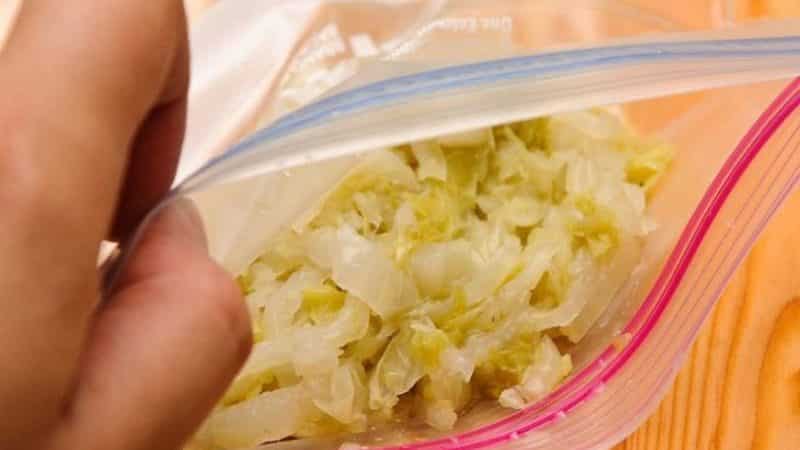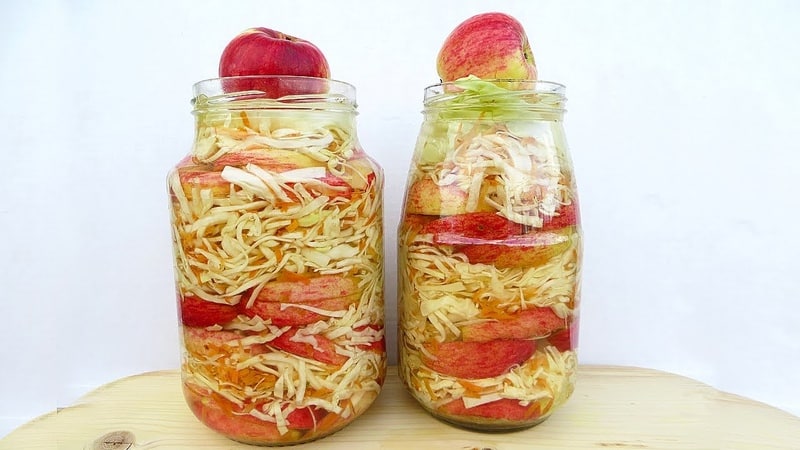We store preparations for a long time: is it possible to freeze sauerkraut and how to do it correctly
Sauerkraut is one of the most famous and widespread winter preparations. If the harvest turns out to be rich and there is an excess of sauerkraut, the problem of storing the product arises. Freezing is one of the best ways to preserve the taste and beneficial properties of a snack.
Is it possible to freeze sauerkraut?
You can definitely freeze this snack. At the same time, it will practically not lose its beneficial properties and taste characteristics.
This storage method involves packing sauerkraut into separate bags, jars or containers - that is, it is laid out in portions.
Points for and against
Like other storage methods, freezing has its advantages and disadvantages. The main advantage is the preservation of nutrients. The main disadvantage of freezing is the change in consistency.

Other benefits of freezing include the following:
- Nutrients are preserved almost unchanged.
- The finished product is always at hand.
- Long shelf life - up to 8 months.
- After quick defrosting, the cabbage is immediately ready to use.
Disadvantages of this storage method:
- Thawed cabbage is not suitable for making salads, as it becomes softer.
- The appearance of the product deteriorates.
- The characteristic crunch disappears.
- The preparation takes up a lot of free space in the freezer or freezer.
- The amount of vitamin C decreases.
How the composition and consistency will change
After freezing, the concentration of vitamin C in the product decreases, although beneficial acids are retained. For this reason, freezing is used as a last resort.
Use the product for cooking or eat within the first few hours after defrosting. The vegetable retains its crunch for the first 3-4 hours, after which becomes soft.
If you are unable to consume the product right away, it is highly not recommended to refreeze the snack - it will lose most of the nutrients and become tasteless.
How to freeze correctly

The refrigerator is well suited for storing sauerkraut, as it is easy to maintain the required temperature. Some housewives freeze the product on a cold balcony, but in this case it all depends on weather conditions.
Before putting the cabbage in the freezer, place it in jars of a suitable size, compact it and cover with lids. Plastic containers or bags are also often used for this purpose, since there is not always room for cans in the freezer.
Basic rules for freezing in bags:
- Cabbage is stored without brine to save space. Also, if the bag breaks, the liquid will not leak.
- The brine must be saved. After thawing, it is poured over the cabbage to return the vitamins and delicate taste of the product. The brine is poured into a plastic bottle, which is screwed tightly and placed in the refrigerator.
- Only thick bags are chosen for freezing. Thin ones are not suitable for these purposes.
It is advisable to freeze the product in two stages. First, lay it out on a flat surface (for example, on a cutting board) and put it in the refrigerator for a couple of hours.Then they are packaged in portions into small bags, these bags are put into a large bag or container and sent to the freezer.
Terms and conditions of storage
Frozen sauerkraut can remain usable for up to 8 months if stored at the correct temperature. The required temperature is -18°C, that is, deep freezing.
How to defrost
In most cases, sauerkraut does not need to be thawed before using. To prepare borscht and other hot dishes, you can use frozen.
If you still need to defrost, just remove the product from the freezer and put it in the refrigerator for several hours. After this it will be ready for use.
How to use
Thawed cabbage is used in the same way as regular cabbage. That is, it is used for making pies, cabbage soup, shanks, potatoes, etc. But it is better not to prepare salads from defrosted cabbage - there will be no characteristic crunch.
Other methods for long-term storage of sauerkraut at home

The storage duration depends on the conditions:
- Refrigerated in a sealed container, the shelf life is 3 months. In an open jar - up to 12 days.
- At room temperature, the product is suitable for use for no more than 3 days.
- In a cellar or on a glazed balcony at a temperature of 0 to +5°C, cabbage is stored for 4-5 months.
It is convenient to store sauerkraut in jars, since such containers do not require much space. The main condition for increasing the shelf life of the product is washing and sterilizing the cans. Thanks to this procedure, pathogenic microflora is destroyed, and this is the most common cause of souring of workpieces.
When storing in jars, cabbage is completely covered with brine, and about 5 mm of sunflower oil is poured on top. The jars are covered with lids and sent to the coolest place in the apartment. This way the blanks are stored for more than a month.
In the refrigerator, cabbage is usually stored in plastic containers, as they take up little space. If the lid is tightly closed, the product will keep for up to 45 days.
In winter, the temperature in cellars often reaches sub-zero levels, due to which cabbage is stored for a relatively long time, especially if the jars are sealed with metal lids. Such blanks will last up to 4-6 months. In summer, this period is reduced to 1 month due to temperature increases above +7°C.
Tips on the topic

Basic tips to help increase shelf life and maintain product quality at a high level:
- To maximize the preservation of nutrients, the cabbage is covered to the top with brine. It is removed from the liquid immediately before serving. If the brine does not cover all the cabbage, it is recommended to use a press to press down the bulk of the workpiece.
- Regular sugar will prevent the cabbage from turning sour. It is used as a preservative that slows down fermentation. Place 1 tablespoon on a three-liter jar.
- Vegetable oil is another powerful preservative. It is poured onto the surface of the brine to prevent oxygen from reaching the cabbage.
- If the product is slightly peroxided, it is used for preparing hot dishes. Before using, sprinkle the cabbage with 1 teaspoon of sugar.
- To protect the product from mold, mustard seeds or mustard powder are added to the product. But this changes the taste of the product slightly - be careful with the quantity.
- Berries added during the preparation of sauerkraut cranberries extend shelf life by approximately 50%.
- Horseradish prevents fungi from developing, which also increases the shelf life of the product. It is added to ready-made picklesso that the fermentation process is not interrupted prematurely.
Conclusion
The duration of storage of sauerkraut directly depends on the conditions that were organized. To maximize shelf life, use sealed containers to prevent the product from coming into contact with air. It is also advisable to ensure a temperature of -18°C or lower.